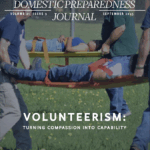The food and agriculture sector is foundational to U.S. prosperity and security. It provides the nation’s population with a stable food supply, underpins the health and productivity of the workforce, and ensures the readiness of the armed forces. The sector also anchors economic stability by supporting millions of jobs, driving exports, and providing the raw materials for countless industries. When agriculture is disrupted, ripple effects reach far beyond farms, creating cascading disruption across health, economic, and security systems that may be difficult to contain.
In California alone, food and agriculture exports account for over 22.4 billion dollars. Yet, despite its designation as one of the nation’s sixteen critical infrastructure sectors, the food and agriculture sector has historically lagged behind other sectors—energy, transportation, finance, and chemicals—in building systemic resilience. This gap is increasingly unsustainable due to the globalization of food supplies and its central role in preparedness, response, and societal stability. Threats to the U.S. supply chain—from cyberattacks and natural disasters to pandemics and global trade disruptions—reveal the fragility of agricultural systems and magnify national security risks.
The recently released National Farm Security Action Plan (NFSAP) emphasizes that protecting food and agriculture is synonymous with protecting national security. While the U.S. Department of Agriculture and state departments of agriculture have long advanced preparedness through programs in plant and animal monitoring, research, and emergency response coordination, these efforts alone cannot fully address the sector’s growing exposure to global and systemic risks. Attention must now turn to the agricultural inputs that underpin national security and resilience. Seeds, fertilizers, feed, water management systems, energy, and pest and disease control materials are not just tools of farm productivity—they are critical resources that sustain food availability and economic stability. The supply chains that deliver these inputs must be secured, diversified, and reinforced to withstand disruptions from geopolitical conflict, biosecurity threats, cyberattacks, or natural disasters. These actions are essential for protecting the broader food and agriculture sector and, by extension, the nation itself.
Food and Agriculture as National Security
Unlike other sectors that focus narrowly on technology or infrastructure, agriculture underpins the most basic requirement of national survival and military readiness by ensuring the ability to feed the population and sustain a warfighting force. As the NFSAP notes, “defending access to American abundance and preserving the American experiment is the essence of agriculture security.” Protecting agricultural inputs and supply chains is therefore not a routine logistics issue—it is a matter of national security and stability.
Agriculture’s role is uniquely strategic. It sustains the civilian workforce and military readiness—both essential to national strength—while stabilizing markets through consumer confidence and providing the foundation for community resilience during crises. A prepared National Guard made up of citizen soldiers helps to prepare local communities in times of disaster.
When food availability is disrupted—whether by fertilizer shortages, transport breakdowns, or the spread of pests, pathogens, and animal or plant diseases—the consequences extend far beyond farms. Public health systems are strained, defense readiness is undermined, and social stability is put at risk. These cascading impacts can lead to long-term consequences that are difficult to recover from, if not impossible.
Food and agriculture form the foundation of national stability, providing the base on which every other critical sector depends. Critical questions that public and private responders should ask include where, when, and how vital inputs originate; how vulnerable distribution routes may be and who maintains them; and how effectively the nation can prevent and respond to biological threats. These threats range from naturally emerging pests and pathogens to invasive species and deliberate acts of contamination—risks highlighted in a June 2025 U.S. Department of Justice case involving the smuggling of harmful agricultural pathogens. Ultimately, the answers to these questions determine whether the United States can feed itself under duress. Addressing them is not only about protecting producers and consumers; it is about safeguarding continuity of operations across society and reinforcing the nation’s security posture.
The Supply Chain Vulnerability Challenge
Food and agricultural production depends on a set of inputs and processes that are increasingly globally dependent in nature, fragile in design, and exposed to disruption. Among the most pressing vulnerabilities are
- Global Supply Chain Dependence: Fertilizers, minerals, nitrogen, and phosphorus are globally traded commodities, and their production is concentrated among a handful of exporters. This reliance makes domestic agriculture highly susceptible to geopolitical shocks, sanctions, or trade disputes. U.S. producers also rely heavily on imported feed ingredients and specialty seeds, many of which are sourced from regions marked by unstable political or trade relationships. Interruptions at any point in these supply chains can quickly ripple across livestock and crop production.
- Energy Dependence: Modern agriculture relies heavily on fossil fuels for machinery, transport, and the production of synthetic fertilizers. Disruptions or price shocks in these energy markets can quickly reverberate across the food system. At the same time, the sector is increasingly exploring renewable and alternative energy sources to enhance long-term sustainability and reduce dependency. However, the transition process itself introduces short-term vulnerabilities—ranging from infrastructure costs to reliability concerns—that must be managed carefully to avoid compounding risks.
- Biosecurity Dependencies:Farming operations remain heavily reliant on pesticides, veterinary products, and other chemical inputs to safeguard plant and animal health. These materials are produced, stored, and transported through networks already designated as critical infrastructure, creating dependencies not only within the food and agriculture sector but also across energy, chemical, and transportation systems. Many of these inputs are sourced internationally, leaving U.S. producers exposed to disruptions in global trade and foreign supply chains. At the same time, emerging pests, pathogens, and invasive species continue to pose serious threats to crop yields and livestock health. Outbreaks—whether naturally occurring, accidental, or intentionally introduced—can cascade across sectors, undermining food availability and requiring large-scale response and recovery efforts.
- Cyber Dependence: The food and agriculture sector is increasingly reliant on digital technologies that introduce significant cybersecurity vulnerabilities. Precision agriculture, automated irrigation, GPS-guided equipment, and smart cold-storage systems are all potential targets for cyberattacks. Threat actors could exploit weaknesses in supervisory control and data acquisition systems, Internet of Things devices, and cloud-based supply chain platforms to disrupt operations or manipulate data. A successful cyber intrusion could halt production, spoil perishable goods, or disrupt and contaminate supply chains. These risks are amplified by limited cybersecurity maturity across many agricultural operations, especially in rural or under-resourced areas, due to aging technology and sector isolation. As the sector digitizes further, cyber risk must become a core component of agricultural infrastructure planning and emergency preparedness.
The NFSAP calls for the development of a federal list of critical agricultural inputs and for systematic assessments of vulnerabilities across transport, processing, and production nodes. This mirrors how the Department of Health and Human Services and the Cybersecurity and Infrastructure Security Agency approach other critical sectors—such as energy, transportation, telecommunications, and water/wastewater, which also depend on minerals, fuels, and chemicals—by identifying dependencies, mapping chokepoints, and directing investments where they are most needed.
Catching Up With Other Critical Infrastructure Sectors
Agriculture does not need to start from scratch to build resilience. Other critical infrastructure sectors have already developed practices that can be adapted to food and agriculture:
- Energy: The energy sector has built continuity through grid interconnections, mutual assistance compacts, and coordination under ESF-12. These mechanisms ensure continuity during disruptions and provide a model for agriculture to develop comparable systems of backup and cross-support.
- Transportation:Transportation networks rely on continuity protocols, safety inspections, and rerouting capabilities to keep goods moving under stress. Applying similar measures to agricultural distribution would help ensure that food and critical inputs flow even when primary routes fail.
- Finance:The financial sector stabilizes itself during crises with rapid access to liquidity, credit, and recovery funds. Extending such mechanisms to agriculture would give producers the financial ability to absorb shocks and sustain operations through recovery.
- Chemical: The chemical sector shows how hazardous inputs can be managed through rigorous oversight and risk assessment. While fertilizers and pesticides are already regulated, existing frameworks focus more on safety and environmental compliance than on supply chain resilience. Strengthening these frameworks to address transparency, redundancy, and interdependencies would reduce vulnerabilities and bring agriculture in line with continuity standards in other critical sectors.
By positioning agriculture alongside these peer sectors, the nation not only elevates its role in national security planning but also lays out a clear, practical path toward modernization and resilience.
Private Sector Dynamics: Market Forces vs. Policy Development
Unlike some other critical infrastructure sectors that are heavily regulated or publicly managed like the energy sector with NERC Reliability Standards, agricultural supply chains are largely driven by the private sector and are profit driven that yield other regulatory standards. This creates a tension between market incentives, prioritized efficiency models, and cost reduction efforts that directly impact resiliency goals, which demand redundancy and preparedness efforts and recovery processes. A few dynamics illustrate this challenge:
- Global sourcing:Lower-cost fertilizers and feed sourced internationally may reduce expenses in the short term but expose producers to strategic vulnerabilities when trade routes are disrupted or exporting nations restrict supply.
- Just-in-time logistics:Efficiency models that minimize storage and inventory reduce operating costs but also eliminate the buffers that could sustain production through crises.
- Capital access:Farmers’ reliance on private credit markets leaves them exposed during emergencies, when lending may tighten precisely when liquidity is most needed.
For agriculture to catch up with other critical infrastructure sectors, policymakers and owner/operators must address these dynamics directly. Federal or state guidance can make resilience a condition of participation in subsidy programs, insurance schemes, or procurement contracts, which is similar to how regulatory frameworks in energy and finance embed security and continuity requirements into market operations.
Global Dependencies and Trade Considerations
The fragility of agricultural inputs is amplified by global dependencies. Recent events, such as the war in Ukraine, have shown how disruptions in fertilizer supply chains can ripple across the globe, driving volatility in food prices and straining producers. Access to these inputs is further shaped by trade policy, which can either stabilize or destabilize supply, depending on how agreements are structured.
- Tariffs and disputes: Protective tariffs may shield domestic industries, but they also invite retaliation that can disrupt access to fertilizers, feed, and other inputs critical to U.S. agriculture.
- International agreements:Well-designed trade frameworks can provide more predictable supply lines, particularly if they incorporate explicit protections for agricultural inputs and prioritize cooperation among allied nations.
Addressing these risks requires more than just securing access through trade. It also demands investment in domestic production and diversification—a strategy consistent with the NFSAP’s recommendation to include key agricultural inputs on critical mineral lists. Balancing global integration with domestic capacity is essential for maintaining continuity in the face of geopolitical and market shocks.
Toward Diversified Inputs
A core element of food and agricultural resilience is diversification. Relying on a narrow set of suppliers or inputs leaves the sector and owners/operators vulnerable to chokepoints and geopolitical shocks. Building a more diversified foundation means drawing from multiple sources, expanding domestic capacity, and preparing substitutes that can sustain production during disruptions.
- Geographic diversification:Establishing multiple fertilizer and feed suppliers across trusted and allied regions reduces exposure to single-country dominance and ensures more stable access during global crises.
- Domestic capacity:Incentivizing U.S.-based production of fertilizers, feed, and specialty seeds—through tax credits, grants, or public–private partnerships—creates a stronger baseline of self-reliance and buffers against global market volatility.
- Alternative agricultural inputs:Investment in substitutes and emerging technologies, such as bio-based fertilizers or novel feed sources, adds flexibility. While these alternatives may not replace conventional systems entirely, they provide critical options during emergencies.
Diversification does not mean abandoning efficiency or profit. Instead, it seeks to strike a balance—retaining the benefits of global markets while ensuring that shocks in one part of the world do not paralyze U.S. food production.
Farm Security as National Security
Food and agriculture can no longer be the nation’s weak link. Farm security is national security. Protecting critical inputs, crops, and supply chains requires the same rigor as has been built into every layer of the system as a long standard in energy, finance, and transportation. That means aligning market efficiency with security imperatives, diversifying supply to blunt global shocks, and hardening fragile nodes that cannot be allowed to fail. Failing to act invites cascading crises in food availability, economic stability, and defense readiness, eroding public trust and weakening the nation from within. America’s ability to endure disruption and feed its people depends on elevating agriculture to its rightful place alongside the other pillars of national security and resilience.

Joshua Dise
Joshua Dise is an interdisciplinary national security and emergency management professional with experience in both operational and analytical roles. His work addresses complex and interconnected risks, including industrial hazards, transboundary diseases, cybersecurity, and systemic threats to critical infrastructure. He currently serves as a systems analyst at Sandia National Laboratories, where he provides decision support on ill-defined, multi-domain national security challenges using a broad range of technical skills and expertise. Prior to this, he served as a lead technical analyst and emergency planner at Sandia, where he was responsible for delivering a variety of hazard analyses and consequence assessment products. His research interests include environmental hazard response, biosecurity, agricultural and public health preparedness, natural resource management and security, and the convergence of digital and physical infrastructure risks. Joshua holds advanced degrees in emergency management and natural resources and is currently a Ph.D. student at Oklahoma State University, studying fire and emergency management administration. He is also an alumnus of the National Preparedness and Leadership Initiative at Harvard University.
- Joshua Disehttps://www.domesticpreparedness.com/author/joshua-dise
- Joshua Disehttps://www.domesticpreparedness.com/author/joshua-dise
- Joshua Disehttps://www.domesticpreparedness.com/author/joshua-dise
- Joshua Disehttps://www.domesticpreparedness.com/author/joshua-dise

Nathan DiPillo
Nathan DiPillo currently serves as a California Governor’s Office appointee assigned to the California Office of Emergency Services as a Critical Infrastructure Analyst in the State Threat Assessment Center. Before state service, he functioned as a critical infrastructure specialist with the Department of Homeland Security, Cybersecurity and Infrastructure Security Agency (CISA). He also spent over 15 years with the Transportation Security Administration, where he assisted in standing up the agency with policy development, training, and recruitment. He has over 25 years in the emergency management and security industry, beginning as a resident firefighter/emergency medical technician. He also served with the California State Military Department, and Army National Guard in the 223rd Training Command ending his career as a Sergeant First Class. During that time, he served in many units, finishing his career attached to the 102nd Military Police Training Division in an Opposition Force Unit. He currently serves on a small-town planning commission and assisted in coordinating an emergency family communications group in his local area. He possesses a master of emergency management/homeland security from the National University and other Federal Emergency Management Agency, U.S. Department of Homeland Security, and military certifications.
- Nathan DiPillohttps://www.domesticpreparedness.com/author/nathan-dipillo
- Nathan DiPillohttps://www.domesticpreparedness.com/author/nathan-dipillo
- Nathan DiPillohttps://www.domesticpreparedness.com/author/nathan-dipillo
- Nathan DiPillohttps://www.domesticpreparedness.com/author/nathan-dipillo







